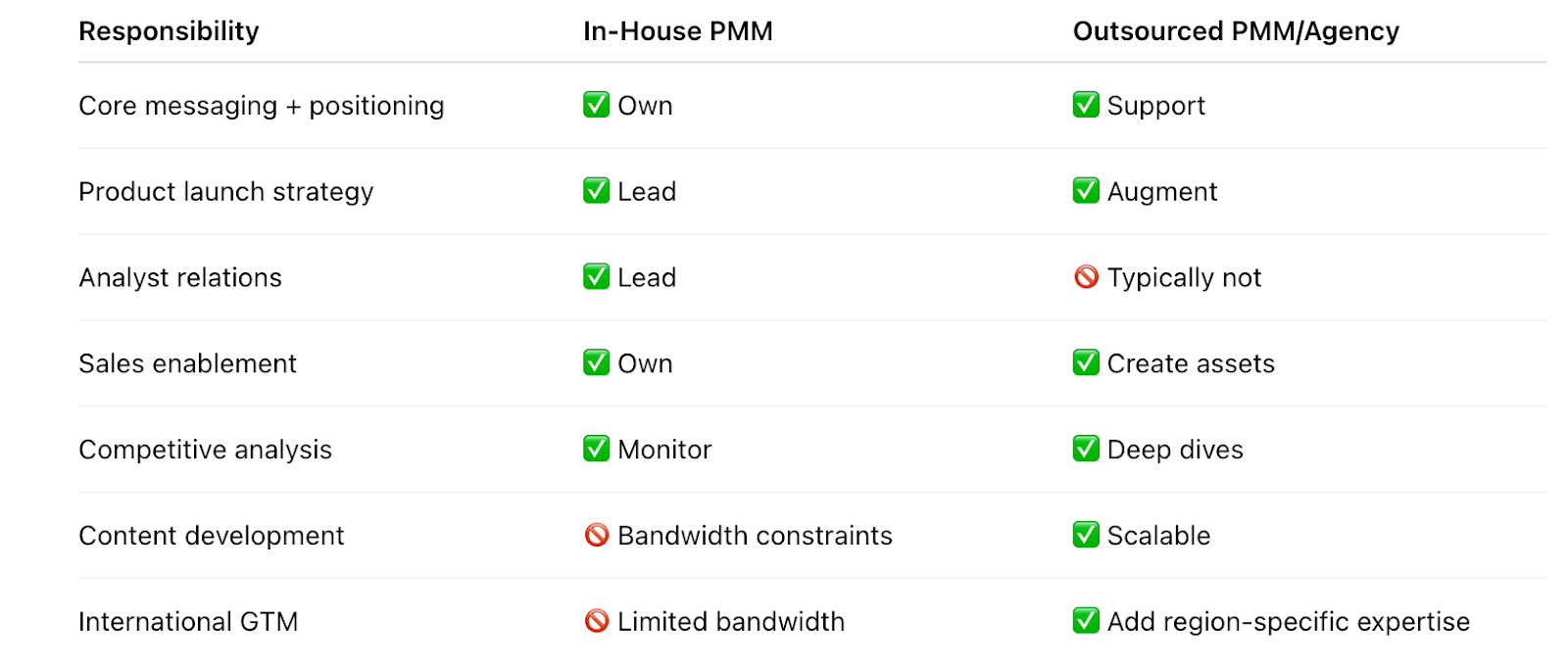Scaling Your Product Marketing Team: In-House vs. Outsourced Talent
Scaling Your Product Marketing Team: In-House vs. Outsourced Talent
As B2B companies scale, so does the complexity of bringing products to market—and with it, the need for a high-performing product marketing team. Whether you’re launching new solutions, targeting new verticals, or evolving your go-to-market (GTM) motion, product marketing is the linchpin that connects product strategy to real-world adoption.
But scaling product marketing isn’t just about adding headcount. It’s about aligning the right skills, structures, and support to deliver strategic impact. And that raises a critical question: should you build your capabilities in-house or bring in outsourced product marketing talent?
This post explores both models in depth, helping B2B leaders choose the best approach to scaling their product marketing team—whether you’re growing rapidly or refining an existing org.
Why Scaling Product Marketing Matters
As your portfolio expands, messaging becomes more complex. New competitors emerge. Your buyers become more sophisticated—and expect more personalized, value-driven engagement.
That’s why scaling your product marketing team isn’t optional—it’s a growth enabler.
A well-resourced team can:
- Build persona-specific messaging across industries and roles
- Enable sales with battlecards, demos, and objection-handling content
- Collaborate with product teams on roadmap validation and launch readiness
- Drive customer adoption, upsells, and expansion revenue
- Create content that supports every stage of the buyer journey
In short, product marketing becomes the connective tissue for growth.
Product marketing plays a critical role in aligning sales and marketing, yet is often under-resourced—making strategic collaboration between these teams essential for driving revenue.
The Case for Building an In-House Product Marketing Team
Hiring a full-time, internal team can offer continuity, control, and cultural alignment. Here’s what makes this model work:
Deep Product and Brand Familiarity
In-house PMMs live and breathe your product. They know your value prop, roadmap, history, and internal dynamics. This gives them a major advantage when shaping GTM strategy or collaborating cross-functionally.
Closer Cross-Team Collaboration
Being embedded in the organization makes it easier to sync with product, sales, CS, and engineering. You’re part of the meetings, Slack channels, and hallway conversations that build alignment.
Long-Term Strategic Ownership
Internal hires can take on ownership of strategic initiatives: entering new markets, running competitive programs, or standing up new vertical motions. They carry institutional knowledge that compounds over time.
But… It Takes Time and Budget
Building a team from scratch is expensive—and time-consuming. Hiring senior PMMs in tech markets like San Francisco or New York can cost over $150K/year per head. Add recruiting fees, ramp time, and onboarding, and you’re looking at a 3–6 month investment per role.
It’s also difficult to scale dynamically. If you’re in hypergrowth mode or need coverage across multiple product lines or regions, you may not be able to hire fast enough.
The Case for Outsourced Product Marketing Talent
Many B2B companies use outsourced product marketing partners—agencies, consultants, or fractional experts—to fill talent gaps quickly and strategically.
Here’s why that works:
Speed and Flexibility
Need to launch a new product in six weeks? Hire a freelance product marketer or an agency with deep launch expertise. Outsourcing gives you on-demand access to execution power—without long-term headcount.
Specialized Expertise
Outsourced partners often bring niche skills—like messaging for cybersecurity buyers, creating sales enablement for a PLG motion, or managing analyst briefings. You get expert work, fast.
Cost Predictability
Instead of fixed salaries, you pay per project, retainer, or time block. This makes it easier to budget and scale without the overhead of full-time employees.
Smart outsourcing can increase agility and reduce fixed costs—critical in volatile markets or during strategic pivots.
But… You’ll Need to Manage Knowledge Gaps
External talent doesn’t know your internal processes or politics. With the right partner – especially one offering senior principal-level engagement – those gaps can be minimal and quickly bridged.
Some B2B leaders also worry about IP or consistency. That’s why it’s important to treat outsourced talent as part of the team, not just task-based vendors.
B2B Marketing Staffing Models: Hybrid Is the New Normal
For most growing B2B orgs, the answer isn’t binary. Often, the best approach to B2B marketing staffing is a hybrid model: an internal team for long-term strategy, supported by flexible, specialized external talent.
Here’s how to structure it:

This mix allows you to grow your marketing org without overcommitting on headcount—and respond faster to market shifts, roadmap changes, or new buyer needs.
When to Scale In-House vs. Outsource
Use this framework to evaluate your needs:
Hire In-House If:
- You’re building a long-term PMM function across multiple product lines
- You need someone to partner deeply with product and sales
- You want to invest in a centralized knowledge base for GTM
- You’re expanding into new markets and need a full-time GTM leader
Hiring your first product marketer is a pivotal step that requires organizational alignment and a clear understanding of GTM readiness.
Outsource If:
- You need to launch something fast and lack bandwidth or exertise
- You’re entering a new industry and need messaging help
- You want to test a new product line without hiring
- You’re overhauling positioning or pricing and need fresh perspective
You can also outsource certain scopes—like competitive audits or win/loss analysis—on a recurring basis to free up internal resources for strategic work. A hybrid model offers flexibility, allowing companies to use in-house staff for brand continuity while outsourcing for specialized speed and execution needs.
Operational Best Practices for Scaling a Product Marketing Team
Whether you hire, outsource, or combine both, you’ll need clear systems and workflows. Here’s how to set your team up for success:
1. Define Roles and Responsibilities
Avoid overlap or confusion by clarifying:
- Who owns positioning and messaging
- Who supports launches vs. leads them
- What’s handled in-house vs. externally
Creating alignment between marketing and sales—whether through internal hires or external partners—can be a key driver of GTM success when teams are structured around enablement goals.
2. Centralize Messaging and Assets
Use a shared repository (like Notion, SharePoint, or Confluence) to store:
- Messaging frameworks
- Launch checklists
- Persona documents
- Sales enablement assets
This helps onboard new hires or external partners faster—and ensures consistency across regions or product lines.
3. Create Feedback Loops
Whether you’re outsourcing or building internally, feedback is key. Set regular check-ins between PMM, sales, product, and leadership. Use tools like Gong or Chorus to hear how messaging lands in real sales calls.
Build in post-mortems after launches to iterate and improve.
4. Measure What Matters
Track performance using both activity and impact metrics. Examples include:
- Sales enablement adoption and usage
- Content performance (views, shares, conversion)
- Time to launch readiness
- Product adoption and NRR growth
Use these insights to decide when and where to scale.
Final Thoughts
Scaling your product marketing team is one of the most critical investments a B2B company can make. Whether you build in-house, outsource, or embrace a hybrid model, your success depends on aligning the right talent, workflows, and strategy to meet business needs.
In-house PMMs bring brand depth and strategic continuity. Outsourced product marketing partners bring speed, flexibility, and specialized expertise. Together, they give you the agility and firepower to drive growth.
As you look to grow your marketing org, focus not just on roles, but on outcomes. Define what success looks like, build the structure to support it, and stay flexible enough to evolve.
Want expert support scaling your product marketing function? Contact Aventi Group to learn how our fractional, project-based, and strategic services can accelerate your GTM success—without the overhead.





